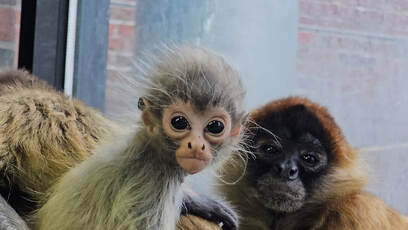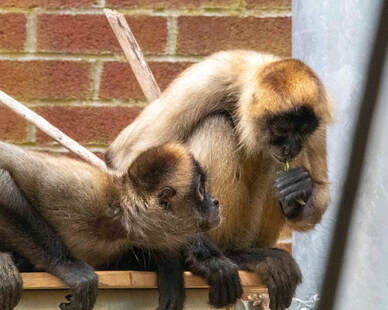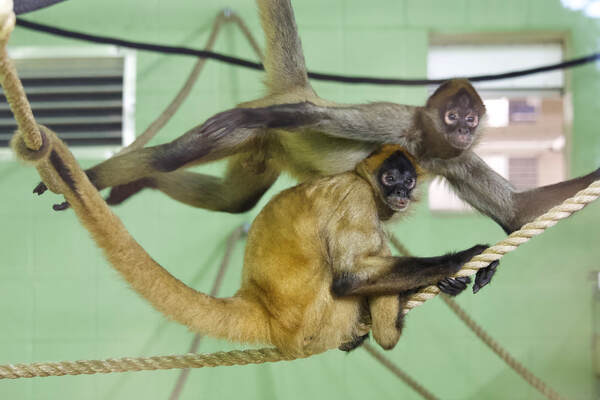Black-Handed Spider Monkey (Ateles geoffroyi)

Physical Description: Black-Handed Spider Monkeys can weigh up to 20 pounds. Their bodies are 15 to 20 inches in length, with arms and legs proportionally longer than the bodies. Their tails can be up to three feet long and act as a fifth limb. The underside of the tail is hairless which allows it to grip branches and food. It also contains sweat glands and sensory nerve endings.
Their fur color varies from light buff to reddish-brown or black, but their hands and feet are black. They have small heads with prominent muzzles that do not have fur. The face is black, and there are light markings, or ocular rings around the eyes.
Black-Handed Spider Monkeys do not have thumbs. They have four hooked fingers allowing them excellent gripping for swinging through tree branches. They are arboreal primates, meaning they live their entire lives in the treetops and very rarely go to the ground. Their method of locomotion is called brachiation: arm over arm swinging through the branches. They have specially adapted joints for this purpose.
They are very vocal and have one of the most highly developed larynxes, giving them the ability to produce a wide range of vocalizations from bird-like calls to barking and guttural grunting. They also communicate via facial expressions, body language, and chemical signals.
Their fur color varies from light buff to reddish-brown or black, but their hands and feet are black. They have small heads with prominent muzzles that do not have fur. The face is black, and there are light markings, or ocular rings around the eyes.
Black-Handed Spider Monkeys do not have thumbs. They have four hooked fingers allowing them excellent gripping for swinging through tree branches. They are arboreal primates, meaning they live their entire lives in the treetops and very rarely go to the ground. Their method of locomotion is called brachiation: arm over arm swinging through the branches. They have specially adapted joints for this purpose.
They are very vocal and have one of the most highly developed larynxes, giving them the ability to produce a wide range of vocalizations from bird-like calls to barking and guttural grunting. They also communicate via facial expressions, body language, and chemical signals.

Habitat: They inhabit rainforests and other tropical forests.
Range: They can be found in forests from southern Mexico into Central America from Nicaragua into northern Costa Rica.
Diet: The bulk of their diet consists of fruits and plant materials, but they will occasionally eat eggs if food is limited
Lifespan: They live on average 27 years in the wild and up to 40 in human care.
Social Structure: Black-Handed Spider Monkeys are very social animals and live in troops of 20 to 40 individuals. There is no defined breeding season. A female usually gives birth to one infant every 2 to 4 years. The mothers will carry the infants on their chests for up to two months after birth when they transition to clinging to the mother’s back. At about three months of age the infants start eating solid food, but they remain with their mothers because they are too small to safely transverse in the treetops. The young remain dependent on their mothers for about 10 months.
Status: Endangered1
Other: Connecticut’s Beardsley Zoo is proud to celebrate the birth of a Black-handed Spider Monkey in August of 2023 to mother Janet and father Gilligan.
1 https://www.iucnredlist.org/species/2279/191688782
Range: They can be found in forests from southern Mexico into Central America from Nicaragua into northern Costa Rica.
Diet: The bulk of their diet consists of fruits and plant materials, but they will occasionally eat eggs if food is limited
Lifespan: They live on average 27 years in the wild and up to 40 in human care.
Social Structure: Black-Handed Spider Monkeys are very social animals and live in troops of 20 to 40 individuals. There is no defined breeding season. A female usually gives birth to one infant every 2 to 4 years. The mothers will carry the infants on their chests for up to two months after birth when they transition to clinging to the mother’s back. At about three months of age the infants start eating solid food, but they remain with their mothers because they are too small to safely transverse in the treetops. The young remain dependent on their mothers for about 10 months.
Status: Endangered1
Other: Connecticut’s Beardsley Zoo is proud to celebrate the birth of a Black-handed Spider Monkey in August of 2023 to mother Janet and father Gilligan.
1 https://www.iucnredlist.org/species/2279/191688782







